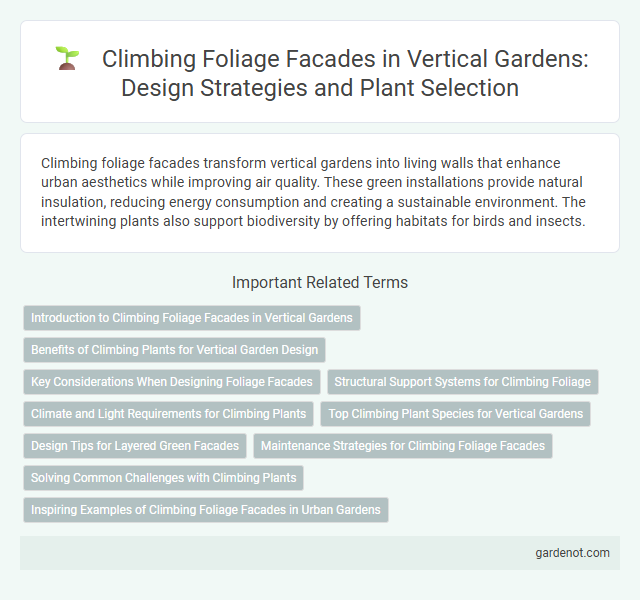Climbing foliage facades transform vertical gardens into living walls that enhance urban aesthetics while improving air quality. These green installations provide natural insulation, reducing energy consumption and creating a sustainable environment. The intertwining plants also support biodiversity by offering habitats for birds and insects.
Introduction to Climbing Foliage Facades in Vertical Gardens
Climbing foliage facades in vertical gardens utilize specialized plants such as ivy, climbing fig, and jasmine to create lush, green walls that enhance urban aesthetics and improve air quality. These facades require support structures like trellises or wire frameworks to guide plant growth vertically, maximizing space in limited urban environments. Integrating climbing plants into building exteriors also provides natural insulation, reducing energy costs and promoting sustainable architecture.
Benefits of Climbing Plants for Vertical Garden Design
Climbing plants enhance vertical garden design by providing natural insulation, which reduces urban heat and lowers energy costs. Their dense foliage improves air quality by filtering pollutants and producing oxygen, promoting a healthier environment. These plants also add aesthetic value through dynamic textures and seasonal greenery, increasing biodiversity and supporting local ecosystems.
Key Considerations When Designing Foliage Facades
Climbing foliage facades require careful selection of plant species suited to the local climate, light exposure, and maintenance capacity to ensure healthy growth and longevity. Structural support systems must be designed to accommodate plant weight and growth patterns, while allowing easy access for pruning and irrigation. Integrating proper irrigation solutions and considering potential impacts on building materials are essential for sustainable and effective foliage facade design.
Structural Support Systems for Climbing Foliage
Structural support systems for climbing foliage facades are essential for maintaining plant stability and growth direction, typically involving trellises, wire meshes, or metal grids anchored firmly to building surfaces. These systems optimize load distribution to prevent damage to both vegetation and the underlying structure, utilizing corrosion-resistant materials such as stainless steel or coated aluminum for durability. Properly designed supports facilitate healthy foliage expansion and enhance vertical garden aesthetics while contributing to facade insulation and environmental benefits.
Climate and Light Requirements for Climbing Plants
Climbing foliage facades thrive in environments with moderate to high humidity and well-drained soil to prevent root rot. These plants require ample indirect sunlight, ideally 4 to 6 hours daily, as too much direct sun can scorch leaves, while insufficient light hinders growth and foliage density. Selecting shade-tolerant species like ivy, jasmine, or philodendron ensures optimal health and aesthetic appeal in vertical garden installations.
Top Climbing Plant Species for Vertical Gardens
Top climbing plant species for vertical gardens include English Ivy (Hedera helix), known for its evergreen foliage and strong clinging ability. Clematis varieties offer vibrant flowers and adaptable growth habits ideal for facades. Climbing hydrangea (Hydrangea anomala petiolaris) thrives in shaded areas, providing dense coverage and white blooms for visually appealing vertical greenery.
Design Tips for Layered Green Facades
Incorporating climbing foliage into vertical gardens enhances layered green facades by combining structural support with diverse plant textures and colors. Selecting species with varying growth habits, such as evergreen vines and flowering climbers, creates depth and seasonal interest. Using modular trellises and staggered planting platforms facilitates optimal light exposure and maintenance accessibility.
Maintenance Strategies for Climbing Foliage Facades
Maintenance strategies for climbing foliage facades emphasize regular pruning to control growth and prevent structural damage, ensuring the plants do not overwhelm building surfaces. Implementing routine inspections allows early detection of pests and diseases, enabling targeted treatments that preserve plant health. Additionally, optimizing irrigation systems tailored for vertical gardens supports consistent moisture levels critical to the sustainability of climbing plants on facades.
Solving Common Challenges with Climbing Plants
Climbing foliage facades effectively address common challenges such as uneven wall coverage and plant maintenance by selecting species like ivy, Virginia creeper, or climbing hydrangea that adapt well to varying light and moisture conditions. Incorporating support structures like trellises or mesh ensures proper plant attachment and growth direction, preventing damage to building surfaces. Regular pruning and monitoring for pests maintain plant health and aesthetic appeal, making vertical gardens both functional and visually striking.
Inspiring Examples of Climbing Foliage Facades in Urban Gardens
Climbing foliage facades transform urban gardens by integrating lush vertical greenery that enhances air quality and aesthetic appeal. Notable examples include the Bosco Verticale in Milan, famous for its dense vegetation enveloping residential towers, and Singapore's Parkroyal on Pickering, where cascading vines soften the building's concrete structure. These designs demonstrate innovative use of climbing plants like ivy, wisteria, and creeping fig to create sustainable, living walls that combat urban heat and boost biodiversity.
Climbing foliage façade Infographic

 gardenot.com
gardenot.com